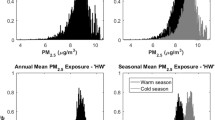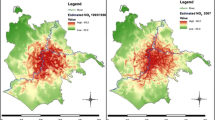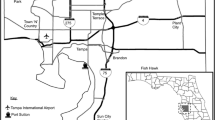Abstract
Residence location has long been used to indicate environmental exposure in many epidemiological studies. This indicator is easy to establish, requires little exposure or monitoring data, and is potentially applicable to many types of investigations. The validity, accuracy and utility of residence location as an exposure indicator, however, is challenged by current concerns regarding multiple exposure pathways, persistent and toxic contaminants, and cumulative exposures from non-point, mobile and point sources. This paper reviews 45 epidemiological studies that use residence location to identify study populations and estimate air pollution exposures. Thirteen (29%) of the studies determined environmental exposures based on “proximity” measures, usually the distance from a subject's residence to a pollutant source. Other studies used “zones” presumed to have equal pollutant levels. Several studies combined zone and proximity approaches. Exposures were quantified using monitoring data in 27 (60%) studies and dispersion modeling in two (4%) studies. Sixteen (36%) studies did not use any environmental data to quantify exposure. A total of 31 (69%) of the studies reported significant associations between health endpoints and the pollutant exposures represented by residence location. In general, comprehensive and systematic approaches to identify and estimate population exposures were not used, and the exposure estimates were therefore deemed likely to have great uncertainty. Unless exposure levels among groups are verified, it cannot be determined whether nonsignificant associations between exposures and health endpoints indicate a lack of measurable health effects, or are merely a result of exposure misclassification. Site-specific and quantitative exposure assessments are needed to better quantify and confirm exposures within such studies, as well as to permit interpretations and comparisons across studies.
Similar content being viewed by others
Author information
Authors and Affiliations
Corresponding author
Rights and permissions
About this article
Cite this article
HUANG, YL., BATTERMAN, S. Residence location as a measure of environmental exposure: a review of air pollution epidemiology studies. J Expo Sci Environ Epidemiol 10, 66–85 (2000). https://doi.org/10.1038/sj.jea.7500074
Received:
Accepted:
Published:
Issue Date:
DOI: https://doi.org/10.1038/sj.jea.7500074
- Springer Nature America, Inc.
Keywords
This article is cited by
-
Residential Proximity to Metal-Emitting Industries and Toenail Metal Concentration in the US Gulf States
Exposure and Health (2024)
-
Drinking water quality status in Malaysia: a scoping review of occurrence, human health exposure, and potential needs
Journal of Exposure Science & Environmental Epidemiology (2023)
-
Artificial intelligence techniques for predicting cardiorespiratory mortality caused by air pollution
International Journal of Environmental Science and Technology (2023)
-
Air pollution and cardiorespiratory hospitalization, predictive modeling, and analysis using artificial intelligence techniques
Environmental Science and Pollution Research (2021)
-
Air pollution and its health impacts in Malaysia: a review
Air Quality, Atmosphere & Health (2020)




